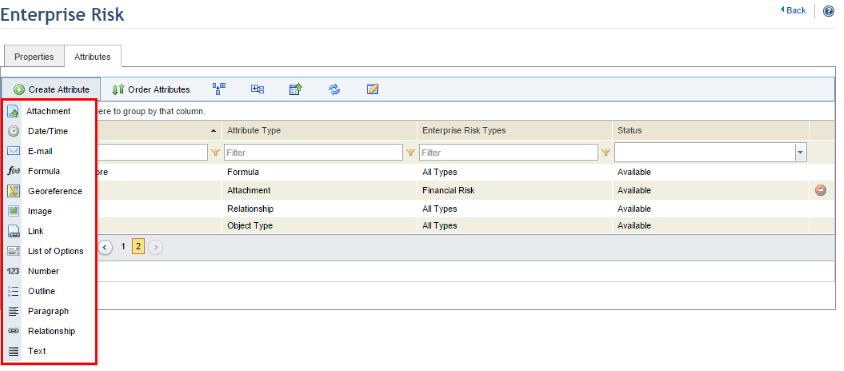
This topic explains how to create attributes for objects provided by Modulo (including assets, business components, perimeters, people, and groups of people, among others), as well as for custom objects created by users. Attributes can also be created for default objects provided with the installation of on-demand solutions, such as the Events and Dispatch solutions, for example. Once registered, these attributes must be published to be available for use in their respective objects. For details, see Chapter 17: Administration -> Customizations -> Objects and Attributes -> How to Publish and Delete Objects and Attributes.
As attributes for Workflow events behave differently, they are explained in a separate topic. For details, see Chapter 17: Administration -> Customizations -> Objects and Attributes -> How to Create an Event Attribute.
Note that the maximum number of attributes that can be created per object is 500, regardless of how many types of objects each attribute was applied to.
The table below displays the list of objects for which there are attribute restrictions and lists which attributes each object supports. Objects that support all types of attributes are not included in the table. Note that custom objects support all types of attributes.
|
|
Asset |
Business Component |
Group of People |
Perimeter |
Person |
Plan |
Procedure |
|
Attachment |
X |
X |
X |
X |
X |
X |
X |
|
Date/Time |
X |
X |
X |
X |
X |
X |
X |
|
|
X |
X |
X |
X |
X |
X |
X |
|
Formula |
X |
X |
X |
X |
X |
X |
X |
|
Georeference |
|
|
|
|
|
|
|
|
Image |
X |
X |
X |
X |
X |
|
|
|
Link |
X |
X |
X |
X |
X |
X |
X |
|
List of Options |
X |
X |
X |
X |
X |
X |
X |
|
Number |
X |
X |
X |
X |
X |
X |
X |
|
Paragraph |
X |
X |
X |
X |
X |
X |
X |
|
Relationship |
X |
X |
X |
X |
X |
|
|
|
Text |
X |
X |
X |
X |
X |
X |
X |
|
Outline |
X |
X |
X |
X |
X |
|
|
1. Access the Administration module.
2. Select Object and Attributes from the Customizations option on the menu.
3. Click Edit next to an object and select the List Attributes option from the drop-down list that appears.
The system displays the list of attributes previously registered for the object selected.
4. Click Create Attribute and select the type of attribute you want to create (see figure below).

The following types of attributes can be created:
•Attachment: used to attach files related to the object (see figure below). Note that, in spreadsheets throughout the system, the fields for this attribute are disabled for editing.
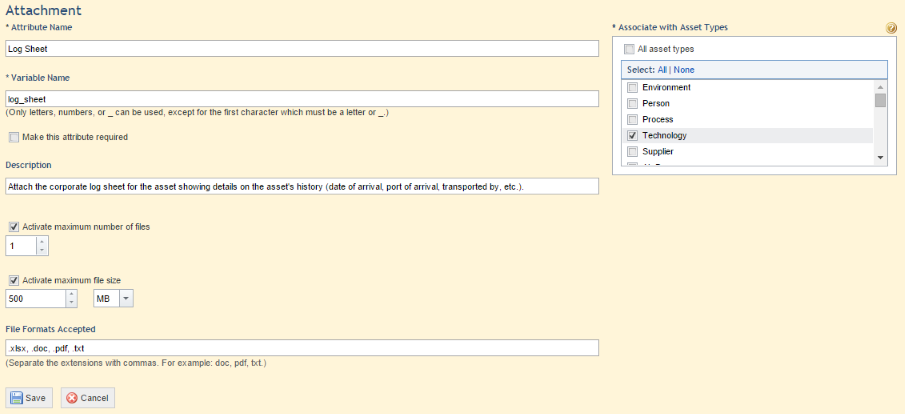
Listed below are explanations for each field to create an Attachment attribute:
|
Field Name |
Description | ||
|
*Attribute Name |
Enter the name of the attribute, as it will appear throughout the system. This field accepts a maximum of 50 characters. | ||
|
*Variable Name |
This variable will be suggested automatically based on the name of the attribute. It cannot be modified once saved, neither can it be the same as any other registered variable. It accepts letters, numbers, or an underscore, except for the first character, which must be a letter or an underscore. This field accepts a maximum of 28 characters. | ||
|
Make this attribute required |
Mark this checkbox if you want the attribute to be a required field in the object when it is completed through forms or the API. Note that workflow rules and integration tasks to import assets from XML files and scanners will not respect this configuration. This behavior also applies when importing objects created through spreadsheets, in which case this attribute will be imported blank to the system, even if marked as required. | ||
|
Description |
Enter a description to help identify the attribute. This description will only appear in the Objects and Attributes section of the Administration module. This field accepts a maximum of 200 characters. | ||
|
|
*Associate with Types of {Object Name} |
Select the object types for which you want the attribute to be available. Any default and custom types created in the Administration module will be available for selection in this field. Keep in mind that in changing the type of object, the published attributes associated with the previous type will be removed and substituted by the attributes of the new type. Note that this field will only be displayed in objects for which a type can be created. |
|
|
Activate maximum number of files |
Mark this checkbox if you want to restrict the number of files that can be uploaded and enter the number in the field below. The maximum number of files accepted by the system is 20. If the checkbox is left unmarked, the system sets the limit to 20 files. | ||
|
Activate maximum file size |
Mark this checkbox if you want to restrict the file size, and then fill out the value and the measurement unit (bytes, kilobytes, or megabytes) in the fields below. If the checkbox is left unmarked, the system sets the limit to 20 MB. | ||
|
File Formats Accepted |
Enter the file formats you want to accept, separated by a comma if there is more than one. No period is necessary before the file extension. This field is not case sensitive. | ||
•Date/Time: used to register information in date, time, or date and time format for objects (see figure below).
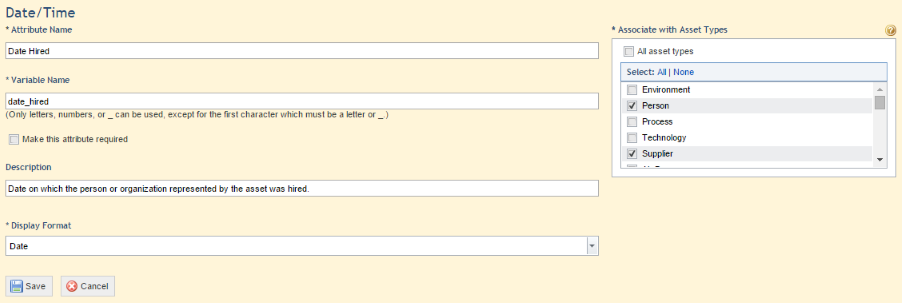
Listed below are explanations for each field to create a Date/Time attribute:
|
Field Name |
Description | |
|
*Attribute Name |
Enter the name of the attribute, as it will appear throughout the system. This field accepts a maximum of 50 characters. | |
|
*Variable Name |
This variable will be suggested automatically based on the name of the attribute. It cannot be modified once saved, neither can it be the same as any other registered variable. It accepts letters, numbers, or an underscore, except for the first character, which must be a letter or an underscore. This field accepts a maximum of 28 characters. | |
|
Make this attribute required |
Mark this checkbox if you want the attribute to be a required field in the object when it is completed through forms, spreadsheets, or the API. Note that workflow rules and integration tasks to import assets from XML files and scanners will not respect this configuration. | |
|
Description |
Enter a description to help identify the attribute. This description will only appear in the Objects and Attributes section of the Administration module. This field accepts a maximum of 200 characters. | |
|
|
*Associate with Types of {Object Name} |
Select the object types for which you want the attribute to be available. Any default and custom types created in the Administration module will be available for selection in this field. Keep in mind that in changing the type of object, the published attributes associated with the previous type will be removed and substituted by the attributes of the new type. Note that this field will only be displayed in objects for which a type can be created. |
|
*Display Format |
Specify if you want only the date, only the time, or both the date and time to be entered as a value for this attribute. This field cannot be edited once the attribute is published. | |
•E-mail: used to include an e-mail address related to the object (see figure below).

Listed below are explanations for each field to create an E-mail attribute:
|
Field Name |
Description |
|
*Attribute Name |
Enter the name of the attribute, as it will appear throughout the system. This field accepts a maximum of 50 characters. |
|
*Variable Name |
This variable will be suggested automatically based on the name of the attribute. It cannot be modified once saved, neither can it be the same as any other registered variable. It accepts letters, numbers, or an underscore, except for the first character, which must be a letter or an underscore. This field accepts a maximum of 28 characters. |
|
Make this attribute required |
Mark this checkbox if you want the attribute to be a required field in the object when it is completed through forms, spreadsheets, or the API. Note that workflow rules and integration tasks to import assets from XML files and scanners will not respect this configuration. |
|
Description |
Enter a description to help identify the attribute. This description will only appear in the Objects and Attributes section of the Administration module. This field accepts a maximum of 200 characters. |
|
*Associate with Types of {Object Name} |
Select the object types for which you want the attribute to be available. Any default and custom types created in the Administration module will be available for selection in this field. Keep in mind that in changing the type of object, the published attributes associated with the previous type will be removed and substituted by the attributes of the new type. Note that this field will only be displayed in objects for which a type can be created. |
•Formula: used to calculate a value based on the properties and attributes of the object (see figure below). This value can be in the following formats: Date/Time, Number, or Text. All default object properties and any custom attributes created for it, except for Attachment, Formula, Image, Outline, and Relationship attributes, can be used in the formula. These properties and attributes will be available for use through the Variables field. You can also create custom variables for use in formulas by using the using the pound (#) as a prefix. For more information on how to write formulas, see Appendix -> Configurations for Formula Attributes.
The value calculated will be updated each time the object is saved in its respective module. However, values must be provided for the properties and attributes used in the formula. Otherwise, the value of the field will be "Undefined Value" in the respective object. Likewise, the formula will be invalid if it contains a variable referring to an attribute that was deleted from the system, in which case the field will display "Invalid Formula (deleted attribute)" in the object. If the formula is divided by zero, the "Invalid Formula (division by zero)" tag will be displayed in the object.
Keep in mind that the value generated by the formula is disabled for editing and that the values from the attributes or properties used in the formula or the formula itself must be changed for a new result to be generated. Also note that, in spreadsheets, the fields for this type of attribute will be disabled for editing and their values will only be recalculated when the spreadsheet is imported.
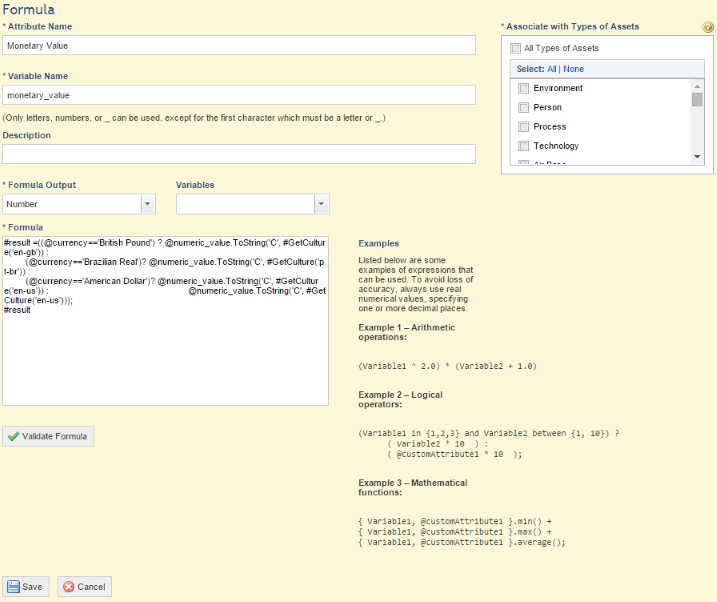
Listed below are explanations for each field to create a Formula attribute:
|
|
Field Name |
Description |
|
|
|
*Attribute Name |
Enter the name of the attribute, as it will appear throughout the system. This field accepts a maximum of 50 characters and the name provided does not need to be unique. |
|
|
|
*Variable Name |
This variable will be suggested automatically based on the name of the attribute. It cannot be modified once saved, neither can it be the same as any other registered variable. It accepts letters, numbers, or an underscore, except for the first character, which must be a letter or an underscore. This field accepts a maximum of 28 characters. |
|
|
|
Description |
Enter a description to help identify the attribute. This description will only appear in the Objects and Attributes section of the Administration module. This field accepts a maximum of 200 characters. |
|
|
*Associate with Types of {Object Name} |
Select the object types for which you want the attribute to be available. Any default and custom types created in the Administration module will be available for selection in this field. Keep in mind that in changing the type of object, the published attributes associated with the previous type will be removed and substituted by the attributes of the new type. Note that this field will only be displayed in objects for which a type can be created. | ||
|
*Formula Output |
Select the format of the value to be generated by the formula (Date/Time, Number, or Text). This field cannot be edited once the attribute is saved. | ||
|
Variables |
This field lists the variables available for the properties and attributes that were associated with the object type selected in the Associate with Types of {Object Name} field. When selecting a variable, it will then be displayed in the Formula field, where it can be combined with the operators and functions available to create the formula. Variables representing custom attributes will be preceded by "@". | ||
|
*Formula |
Enter the formula to be used by selecting the variables and writing the mathematical functions available. | ||
•Georeference: used to include a point or a set of points on a map related to the object (see figure below). Note that attributes of this type are only available for custom objects and objects from the ERM, Policy, Dispatch, and Events solutions.
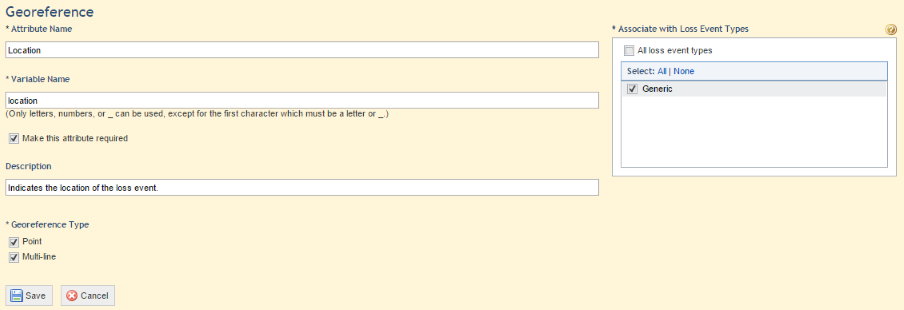
Listed below are explanations for each field to create a Georeference attribute:
|
Field Name |
Description |
|
*Attribute Name |
Enter the name of the attribute, as it will appear throughout the system. This field accepts a maximum of 50 characters. |
|
*Variable Name |
This variable will be suggested automatically based on the name of the attribute. It cannot be modified once saved, neither can it be the same as any other registered variable. It accepts letters, numbers, or an underscore, except for the first character, which must be a letter or an underscore. This field accepts a maximum of 28 characters. |
|
Make this attribute required |
Mark this checkbox if you want the attribute to be a required field in the object when it is completed through forms, spreadsheets, or the API. Note that workflow rules and integration tasks to import assets from XML files and scanners will not respect this configuration. |
|
Description |
Enter a description to help identify the attribute. This description will only appear in the Objects and Attributes section of the Administration module. This field accepts a maximum of 200 characters. |
|
*Georeference Type |
Mark the checkbox next to the type that you want to use. Point is used to place a single point on the map, while Multi-line is used to mark multiple interconnected points. This field cannot be edited once the attribute is published. |
|
*Associate with Types of {Object Name} |
Select the object types for which you want the attribute to be available. Any default and custom types created in the Administration module will be available for selection in this field. Keep in mind that in changing the type of object, the published attributes associated with the previous type will be removed and substituted by the attributes of the new type. Note that this field will only be displayed in objects for which a type can be created. |
•Image: used to include images related to the object (see figure below). Note that, in spreadsheets throughout the system, the fields for this attribute are disabled for editing. Attributes of this type are not available for plans or procedures.
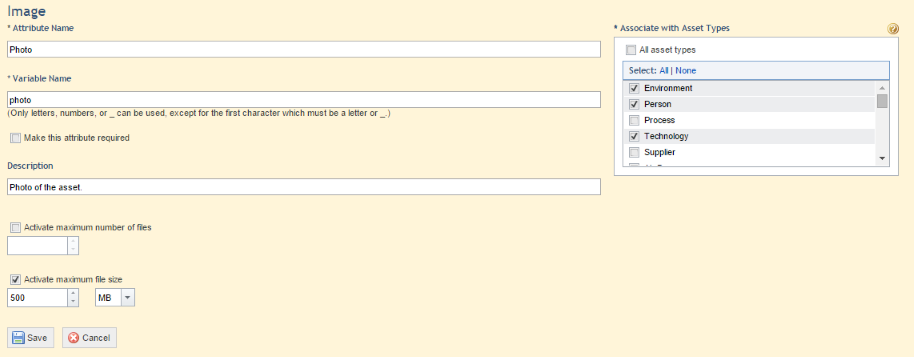
Listed below are explanations for each field to create an Image attribute:
|
Field Name |
Description |
|
*Attribute Name |
Enter the name of the attribute, as it will appear throughout the system. This field accepts a maximum of 50 characters. |
|
*Variable Name |
This variable will be suggested automatically based on the name of the attribute. It cannot be modified once saved, neither can it be the same as any other registered variable. It accepts letters, numbers, or an underscore, except for the first character, which must be a letter or an underscore. This field accepts a maximum of 28 characters. |
|
Make this attribute required |
Mark this checkbox if you want the attribute to be a required field in the object when it is completed through forms, spreadsheets, or the API. Note that workflow rules and integration tasks to import assets from XML files and scanners will not respect this configuration. This behavior also applies when importing objects created through spreadsheets, in which case this attribute will be imported blank to the system, even if marked as required. |
|
Description |
Enter a description to help identify the attribute. This description will only appear in the Objects and Attributes section of the Administration module. This field accepts a maximum of 200 characters. |
|
*Associate with Types of {Object Name} |
Select the object types for which you want the attribute to be available. Any default and custom types created in the Administration module will be available for selection in this field. Keep in mind that in changing the type of object, the published attributes associated with the previous type will be removed and substituted by the attributes of the new type. Note that this field will only be displayed in objects for which a type can be created. |
|
Activate maximum number of files |
Mark this checkbox if you want to restrict the number of files that can be uploaded and enter the number in the field below. The maximum number of files accepted by the system is 20. If the checkbox is left unmarked, the system sets the limit to 20 files. |
|
Activate maximum file size |
Mark this checkbox if you want to restrict the file size, and then fill out the value and the measurement unit (bytes, kilobytes, or megabytes) in the fields below. If the checkbox is left unmarked, the system sets the limit to 20 MB. |
•Link: used to include a link related to the object (see figure below).

Listed below are explanations for each field to create a Link attribute:
|
Field Name |
Description |
|
*Attribute Name |
Enter the name of the attribute, as it will appear throughout the system. This field accepts a maximum of 50 characters. |
|
*Variable Name |
This variable will be suggested automatically based on the name of the attribute. It cannot be modified once saved, neither can it be the same as any other registered variable. It accepts letters, numbers, or an underscore, except for the first character, which must be a letter or an underscore. This field accepts a maximum of 28 characters. |
|
Make this attribute required |
Mark this checkbox if you want the attribute to be a required field in the object when it is completed through forms, spreadsheets, or the API. Note that workflow rules and integration tasks to import assets from XML files and scanners will not respect this configuration. |
|
Description |
Enter a description to help identify the attribute. This description will only appear in the Objects and Attributes section of the Administration module. This field accepts a maximum of 200 characters. |
|
*Associate with Types of {Object Name} |
Select the object types for which you want the attribute to be available. Any default and custom types created in the Administration module will be available for selection in this field. Keep in mind that in changing the type of object, the published attributes associated with the previous type will be removed and substituted by the attributes of the new type. Note that this field will only be displayed in objects for which a type can be created. |
•List of Options: used to include a list of information related to the object (see figure below).
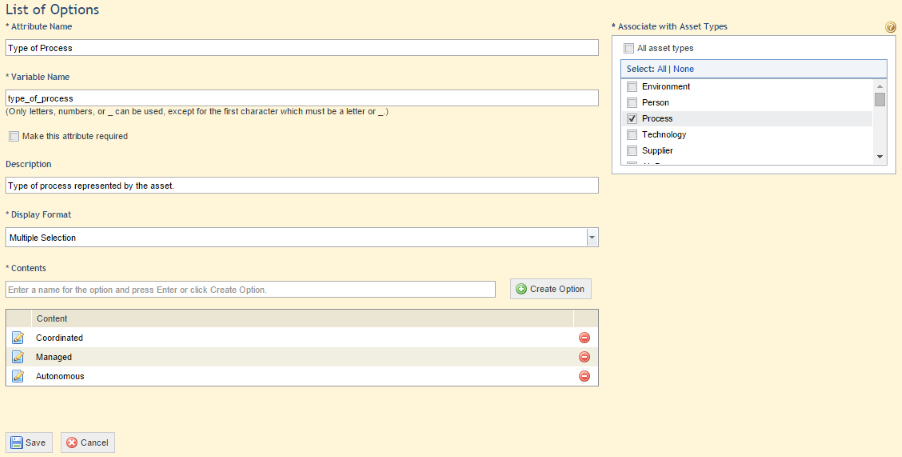
Listed below are explanations for each field to create a List of Options attribute:
|
Field Name |
Description |
|
*Attribute Name |
Enter the name of the attribute, as it will appear throughout the system. This field accepts a maximum of 50 characters. |
|
*Variable Name |
This variable will be suggested automatically based on the name of the attribute. It cannot be modified once saved, neither can it be the same as any other registered variable. It accepts letters, numbers, or an underscore, except for the first character, which must be a letter or an underscore. This field accepts a maximum of 28 characters. |
|
Make this attribute required |
Mark this checkbox if you want the attribute to be a required field in the object when it is completed through forms, spreadsheets, or the API. Note that workflow rules and integration tasks to import assets from XML files and scanners will not respect this configuration. |
|
Description |
Enter a description to help identify the attribute. This description will only appear in the Objects and Attributes section of the Administration module. This field accepts a maximum of 200 characters. |
|
*Associate with Types of {Object Name} |
Select the object types for which you want the attribute to be available. Any default and custom types created in the Administration module will be available for selection in this field. Keep in mind that in changing the type of object, the published attributes associated with the previous type will be removed and substituted by the attributes of the new type. Note that this field will only be displayed in objects for which a type can be created. |
|
*Display Format |
Specify if you want to allow only one or more than one option to be selected. This field cannot be edited once the attribute is published. |
|
*Contents |
Enter the options that will be available for selection when choosing the value of the attribute. After entering an option, click Create Option to save it. Note that you can change the order in which the options appear by dragging and dropping them into place. To delete an option, click Delete. |
•Number: used to register numeric information related to the object (see figure below).
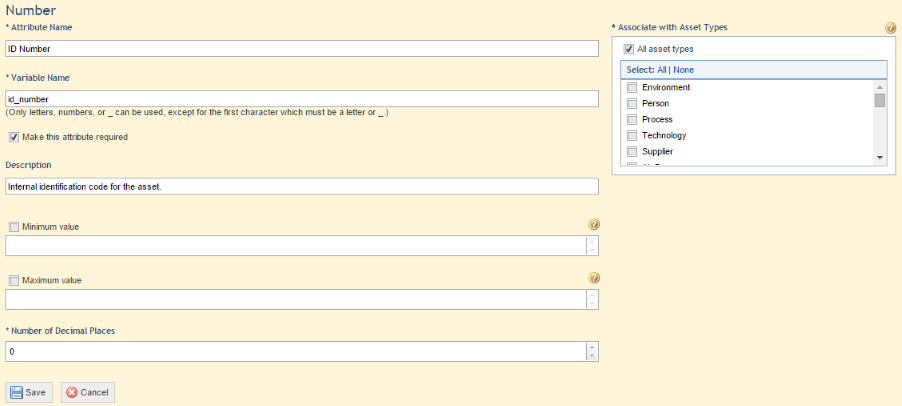
Listed below are explanations for each field to create a Number attribute:
|
Field Name |
Description |
|
*Attribute Name |
Enter the name of the attribute, as it will appear throughout the system. This field accepts a maximum of 50 characters. |
|
*Variable Name |
This variable will be suggested automatically based on the name of the attribute. It cannot be modified once saved, neither can it be the same as any other registered variable. It accepts letters, numbers, or an underscore, except for the first character, which must be a letter or an underscore. This field accepts a maximum of 28 characters. |
|
Make this attribute required |
Mark this checkbox if you want the attribute to be a required field in the object when it is completed through forms, spreadsheets, or the API. Note that workflow rules and integration tasks to import assets from XML files and scanners will not respect this configuration. |
|
Description |
Enter a description to help identify the attribute. This description will only appear in the Objects and Attributes section of the Administration module. This field accepts a maximum of 200 characters. |
|
*Associate with Types of {Object Name} |
Select the object types for which you want the attribute to be available. Any default and custom types created in the Administration module will be available for selection in this field. Keep in mind that in changing the type of object, the published attributes associated with the previous type will be removed and substituted by the attributes of the new type. Note that this field will only be displayed in objects for which a type can be created. |
|
Minimum value |
Mark the checkbox if you want to require that a minimum numerical value be entered in the attribute, and then enter the value in the field. This will require that at least a certain value be entered before the system accepts the value entered for the attribute. |
|
Maximum value |
Mark the checkbox if you want to require that a maximum numerical value be entered in the attribute, and then enter the value in the field. This will require the value provided to respect the maximum value which, if exceeded, will cause the system to reject the value provided for the attribute. The system allows a maximum value of up to ten digits. |
|
*Number of decimal places |
Enter the number of decimal places that the system will accept as values entered for this type of attribute. |
•Outline: used to register information on the object through an outline, which can be bulleted or numbered (see figure below). Note that attributes of this type are not available for plans and procedures.

Listed below are explanations for each field to create an Outline attribute:
|
Field Name |
Description |
|
*Attribute Name |
Enter the name of the attribute, as it will appear throughout the system. This field accepts a maximum of 50 characters. |
|
*Variable Name |
This variable will be suggested automatically based on the name of the attribute. It cannot be modified once saved, neither can it be the same as any other registered variable. It accepts letters, numbers, or an underscore, except for the first character, which must be a letter or an underscore. This field accepts a maximum of 28 characters. |
|
Make this attribute required |
Mark this checkbox if you want the attribute to be a required field in the object when it is completed through forms, spreadsheets, or the API. Note that workflow rules and integration tasks to import assets from XML files and scanners will not respect this configuration. |
|
Description |
Enter a description to help identify the attribute. This description will only appear in the Objects and Attributes section of the Administration module. This field accepts a maximum of 200 characters. |
|
*Associate with Types of {Object Name} |
Select the object types for which you want the attribute to be available. Any default and custom types created in the Administration module will be available for selection in this field. Keep in mind that in changing the type of object, the published attributes associated with the previous type will be removed and substituted by the attributes of the new type. Note that this field will only be displayed in objects for which a type can be created. |
|
*Display Format |
Specify if the outline format should be bulleted or numbered. This field cannot be edited once the attribute is published. |
•Paragraph: used to register general information on the object in the form of a paragraph (see figure below).

Listed below are explanations for each field to create a Paragraph attribute:
|
Field Name |
Description |
|
*Attribute Name |
Enter the name of the attribute, as it will appear throughout the system. This field accepts a maximum of 50 characters. |
|
*Variable Name |
This variable will be suggested automatically based on the name of the attribute. It cannot be modified once saved, neither can it be the same as any other registered variable. It accepts letters, numbers, or an underscore, except for the first character, which must be a letter or an underscore. This field accepts a maximum of 28 characters. |
|
Make this attribute required |
Mark this checkbox if you want the attribute to be a required field in the object when it is completed through forms, spreadsheets, or the API. Note that workflow rules and integration tasks to import assets from XML files and scanners will not respect this configuration. |
|
Description |
Enter a description to help identify the attribute. This description will only appear in the Objects and Attributes section of the Administration module. This field accepts a maximum of 200 characters. |
|
*Associate with Types of {Object Name} |
Select the object types for which you want the attribute to be available. Any default and custom types created in the Administration module will be available for selection in this field. Keep in mind that in changing the type of object, the published attributes associated with the previous type will be removed and substituted by the attributes of the new type. Note that this field will only be displayed in objects for which a type can be created. |
•Relationship: used to create relationships between system objects (see figure below). These attributes can be created for custom objects (for use through the API and custom modules) and default objects (except events from the Workflow module and plans and procedures from the Continuity module) so that they can be associated with other objects.
When creating an attribute of this type, a system object must be selected so that specific objects can be associated with it later. For example, an asset attribute named "Auditor Responsible" can be created with "Person" as the associated object. In certain objects, when entering value for this attribute, a list of the people registered in the system will appear so that a certain person can be selected for it.
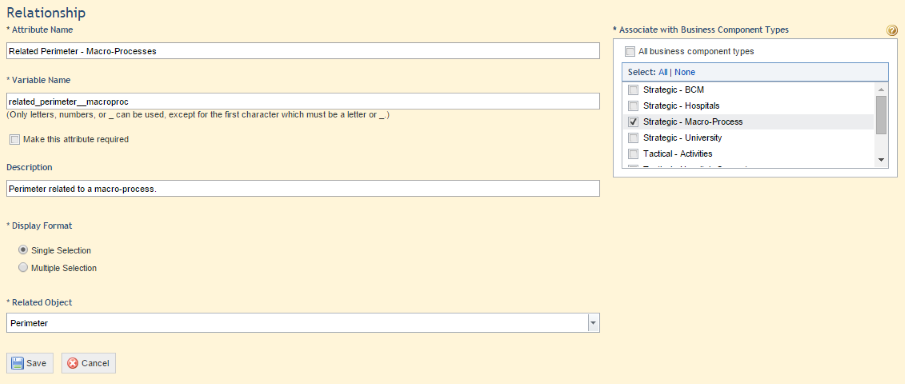
Listed below are explanations for each field to create a Relationship attribute:
|
Field Name |
Description |
|
*Attribute Name |
Enter the name of the attribute, as it will appear throughout the system. This field accepts a maximum of 50 characters. |
|
*Variable Name |
This variable will be suggested automatically based on the name of the attribute. It cannot be modified once saved, neither can it be the same as any other registered variable. It accepts letters, numbers, or an underscore, except for the first character, which must be a letter or an underscore. This field accepts a maximum of 28 characters. |
|
Make this attribute required |
Mark this checkbox if you want the attribute to be a required field in the object when it is completed through forms, spreadsheets, or the API. Note that workflow rules and integration tasks to import assets from XML files and scanners will not respect this configuration. |
|
Description |
Enter a description to help identify the attribute. This description will only appear in the Objects and Attributes section of the Administration module. This field accepts a maximum of 200 characters. |
|
*Associate with Types of {Object Name} |
Select the object types for which you want the attribute to be available. Any default and custom types created in the Administration module will be available for selection in this field. Keep in mind that in changing the type of object, the published attributes associated with the previous type will be removed and substituted by the attributes of the new type. Note that this field will only be displayed in objects for which a type can be created. |
|
* Display Format |
Specify whether only one or several objects will be accepted by the attribute. This field cannot be edited once the attribute is published. |
|
* Related Object |
Select the object to be associated. All instances of the object selected will be available for selection when entering a value for the attribute. |
•Text: used to register information on the object in text format (see figure below). You can include a regular expression mask, which indicates how the field should be completed and prevents users from providing invalid information in it. For example, a field can be created for an IP address configured only to accept the default format for this value.
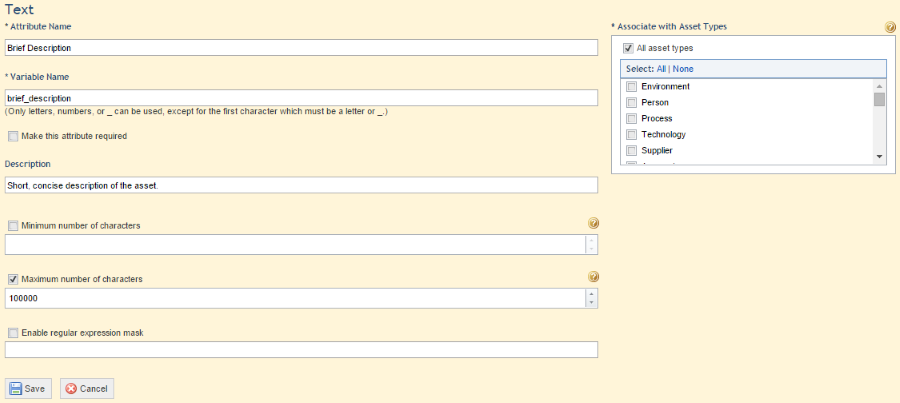
Listed below are explanations for each field to create a Text attribute:
|
Field Name |
Description |
|
*Attribute Name |
Enter the name of the attribute, as it will appear throughout the system. This field accepts a maximum of 50 characters. |
|
*Variable Name |
This variable will be suggested automatically based on the name of the attribute. It cannot be modified once saved, neither can it be the same as any other registered variable. It accepts letters, numbers, or an underscore, except for the first character, which must be a letter or an underscore. This field accepts a maximum of 28 characters. |
|
Make this attribute required |
Mark this checkbox if you want the attribute to be a required field in the object when it is completed through forms, spreadsheets, or the API. Note that workflow rules and integration tasks to import assets from XML files and scanners will not respect this configuration. |
|
Description |
Enter a description to help identify the attribute. This description will only appear in the Objects and Attributes section of the Administration module. This field accepts a maximum of 200 characters. |
|
*Associate with Types of {Object Name} |
Select the object types for which you want the attribute to be available. Any default and custom types created in the Administration module will be available for selection in this field. Keep in mind that in changing the type of object, the published attributes associated with the previous type will be removed and substituted by the attributes of the new type. Note that this field will only be displayed in objects for which a type can be created. |
|
Minimum number of characters |
Mark the checkbox to require that a minimum number of characters be entered in the value of the attribute, and then specify the number in the field that is enabled. The system will then only accept values for attributes of this type with this minimum value entered. |
|
Maximum number of characters |
Mark the checkbox to require that a maximum number of characters be entered in the value of the attribute, and then specify the number in the field that is enabled. The system will not accept values for this type of attribute that exceed the maximum size specified here. |
|
Enable regular expression mask |
Mark the checkbox to enable a regular expression mask for this type of attribute, and then enter the mask in the field below that is enabled. For details on creating masks, see Appendix -> Masks -> Regular Expression Masks in Attributes. |
5. When finished, click Save. If you want to quit the operation, click Cancel.
The system displays a success message.